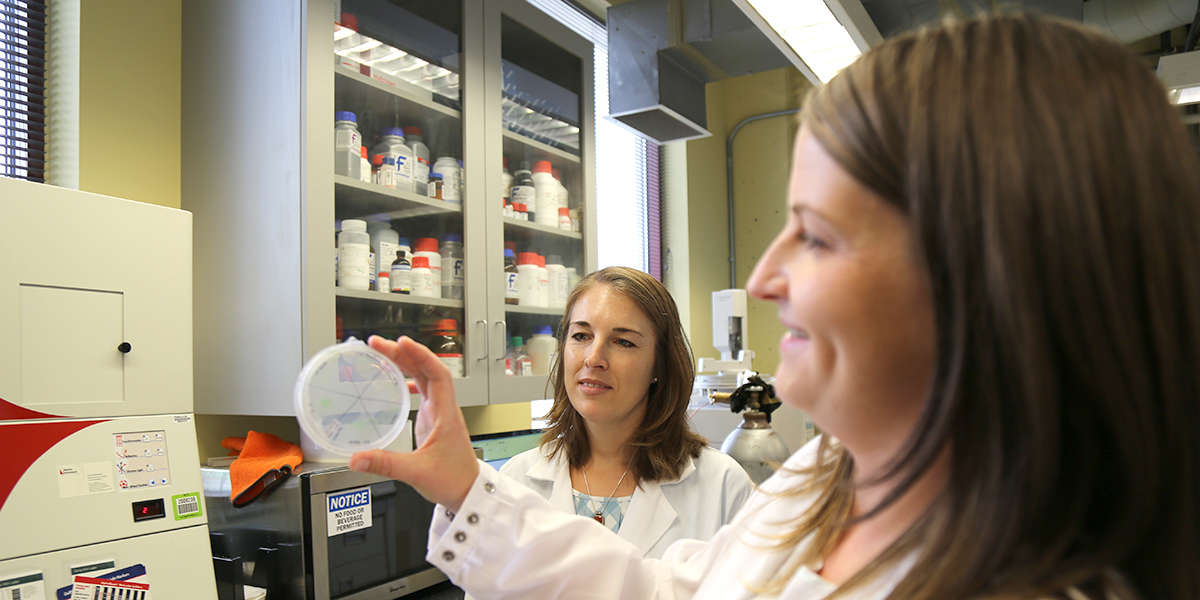Faculty in the departments of Chemistry and Chemical and Biological Engineering have been awarded $320,000 by the National Science Foundation to turn bacteria into a more sustainable source of jet fuel.

Chemistry Assistant Research Professor Fiona Davies, left, and Chemical and Biological Engineering Assistant Professor Nanette Boyle inspect a dish of blue-green algae.
CBE Assistant Professor Nanette Boyle, principal investigator, and Chemistry Assistant Research Professor Fiona Davies, co-PI, are using photosynthetic bacteria commonly known as blue-green algae to produce a compound called limonene.
“Limonene is the compound in citrus essential oils which gives them their distinctive scent,” Davies said. “It’s an ideal precursor for aviation fuel because of its high energy density and structural similarity to jet fuel.” This means limonene can simply be blended with current petroleum-based fuels with no changes needed in the existing transport fuel infrastructure.
While some of the increasing demand for energy in the transportation sector can be replaced with vehicles that run on renewable electricity, the aviation, shipping and long-haul trucking industries will still require liquid fuel.
The bacteria—Synechococcus sp. PC 7002—is very similar to plants in that it grows on carbon dioxide and light alone. It essentially functions as a catalytic factory where enzymes in the cell directly convert carbon dioxide into limonene.
“It doesn’t produce limonene naturally, but we have engineered it to produce limonene by introducing a single enzyme from a limonene-producing plant—spearmint,” Boyle said. “Our current limonene production yields are not high enough to be economically feasible, therefore the funded research is focused on rewiring the metabolism of the cell to direct more carbon toward limonene.”
Boyle and Davies will use computational modeling to predict how they can divert more carbon flux to limonene, then use genetic engineering techniques to modify the bacterium’s metabolism to increase production.
Cyanobacteria—or bacteria that obtain their energy through photosynthesis—have been engineered to produce various industrially useful compounds such as ethanol, butanol and isoprene, which Davies has worked with previously. However, yields are typically low, and little progress has been made because the metabolism of the cell is so tightly controlled. “Our study will actually pinpoint where the tightly controlled parts of metabolism are so that we eliminate them specifically,” Davies said.
“Overall, our work will develop a far more sustainable and environmentally friendly source of fuel for the aviation industry because it is produced directly from carbon in the atmosphere instead of the limited fossil fuel reserves, and it removes carbon from the atmosphere to assist with efforts to reduce global warming,” Boyle said.
The project will also include educational activities, with Boyle and Davies mentoring a team of college and high school students to participate in the International Genetically Engineered Machines competition. The program, also known as iGEM, promotes active learning in the field of molecular biology.
Contact:
Mark Ramirez, Communications Manager, College of Applied Science & Engineering | 303-384-2622 | ramirez@mines.edu
Ashley Spurgeon, Editorial Assistant, Mines magazine | 303-273-3959 | aspurgeon@mines.edu



